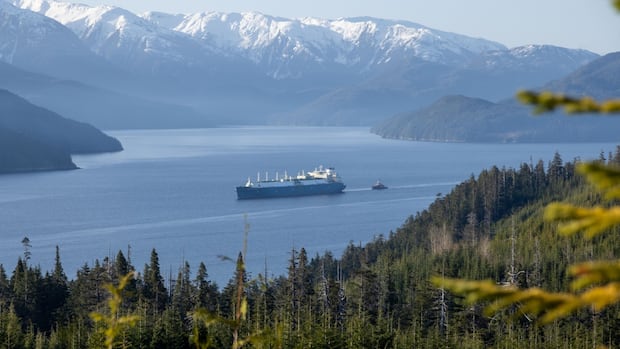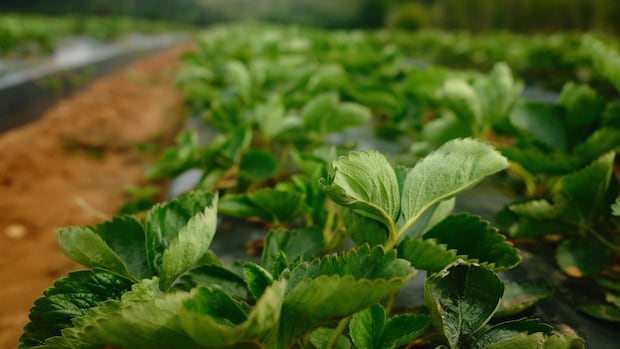Upon first walking into the screenhouse at the Kentville Research and Development Centre, a casual observer might simply see rows of regular strawberry plants.
But a closer look shows plenty of variety. There are large leaves, small leaves, taller plants, shorter plants, and different hues of green.
Beatrice Amyotte sees potential in all of these differences. As a research scientist at the centre, it's her job to help develop varieties that both succeed for growers and produce berries that consumers love.
As Canada's climate changes, that task becomes trickier.
"Some of the predictions that have been made for the coming 10 to 20 years is that Nova Scotia will increase the amount of water it receives and increase the amount of heat it receives. So we're looking in the future at hotter and wetter conditions," Amyotte said.
 Beatrice Amyotte is a research scientist at the Kentville Research and Development Centre in Kentville, N.S. (Frances Willick/CBC)
Beatrice Amyotte is a research scientist at the Kentville Research and Development Centre in Kentville, N.S. (Frances Willick/CBC)Climate models suggest extreme conditions, too, are becoming more likely, she said.
"The weather patterns are changing over time, and so something that can withstand a drier year, a colder year, a wetter year and still have good productivity under all those conditions is more likely to be resilient to climate change.
"So potentially that will be a variety that's important to growers and potentially it will be a good parent for the future of our breeding."
The screenhouse — like a greenhouse, but with screens instead of plastic or glass sides — contains 160 varieties of strawberry plants that will be either distributed to nurseries across Canada next spring or tested in the fields at the research centre in Kentville, N.S., and other research centres in Canada.
 These raspberries are among the varieties being tested at the Kentville Research and Development Centre. (Frances Willick/CBC)
These raspberries are among the varieties being tested at the Kentville Research and Development Centre. (Frances Willick/CBC)Amyotte's work with the Canadian Berry Trial Network involves growing the same varieties at different locations across Canada over several years. Understanding which varieties perform well under certain growing conditions can help narrow down the varieties that will thrive through climate change.
For instance, varieties that are tolerant of flooding conditions in B.C. may be a good variety to consider for Nova Scotia as the climate becomes wetter. Or varieties that were successful in Nova Scotia under this year's drought conditions could perform well in areas that are expected to experience those conditions more often due to climate change.
Challenges for growersPhilip Keddy knows the unpredictability that comes with climate change.
"I believe we've been for the last 10 years starting to see the effects of climate change," said the owner of Charles Keddy Farms near Kentville. "We've had some of the wettest years, some of the driest years, colder temperatures in the winter, just drastic fluctuation and temperatures and moisture."
Those challenging growing conditions can affect the bottom line, with reduced yields or increased costs for irrigation.
Keddy grows strawberry plants to send to farmers in the U.S. and Canada, creating millions of replicas of the original plant using runners, or horizontal shoots, that then root to create a new plant.
 Philip Keddy is the owner of Charles Keddy Farms, which grows varieties of strawberries created at the Kentville Research and Development Centre for sale to commercial growers. (Frances Willick/CBC)
Philip Keddy is the owner of Charles Keddy Farms, which grows varieties of strawberries created at the Kentville Research and Development Centre for sale to commercial growers. (Frances Willick/CBC)He works closely with Amyotte and the research centre to find varieties that work for the conditions his customers are facing and the properties they want in a berry.
His customers in Florida, for example, want a berry that lasts on the shelf for a week or more, while the varieties sold in Canada tend to have a shorter shelf life but more flavour and texture.
As growers face varying conditions, Keddy must carefully choose the varieties he sends them in the hopes they'll be up to the challenge.
"Once we know certain varieties can handle below X weather, that's what we then use as a sales pitch to say, OK, you're in Alberta, you're in Saskatchewan, your winters are way colder than ours. These varieties are more likely to do better in your climate."
Slow processThe process of developing a new variety that can withstand changing climate conditions is slow.
Amyotte said it can take 10 to 15 years to bring a new strawberry variety from seed to being ready for commercial growing, and longer for raspberries and blueberries.
She said the next step in her efforts to create varieties that can withstand climate change will involve tweaking the growing conditions to mimic specific stresses, such as excessive water or heat.
 Scientists at the Kentville Research and Development Centre use instruments to analyze the colour, firmness and glossiness of berries. (Galen McRae/CBC)
Scientists at the Kentville Research and Development Centre use instruments to analyze the colour, firmness and glossiness of berries. (Galen McRae/CBC) 










